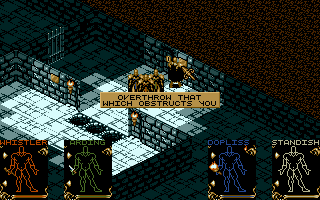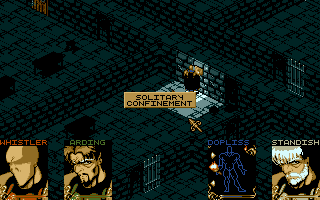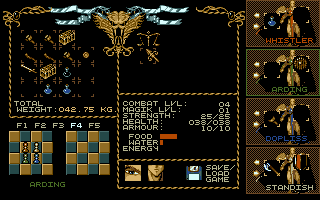From The CRPG Addict
 |
| That’s maybe not a torch I’d want to carry in a cramped hallway. |
Total Hours: 8 (unfinished)
Difficulty: Hard (4/5)
Final Rating: (to come later)
Ranking at time of posting: (to come later)
This is simply a genre that I’m never going to take to. I didn’t like DarkSpyre; I didn’t like Legends; I didn’t like Heimdall. I developed a fondness for Dungeon Master, but largely because it had a good combat, magic, and character development system alongside its many buttons and pressure plates. I like the occasional puzzle, but not so much the switch-and-pressure-plate variety. There’s a reason there’s no “puzzles” category in my GIMLET. I say this with all respect to people who really do enjoy them. The world would be boring if we all liked the same things.
I would have persevered if not for a few other “features.” One thing I hate about any game–and I don’t mention this often because it rarely comes up–is the sense that the game is nipping at my heels. The occasional timed puzzle or quest is fine, but if the entire thrust of the gameplay is to impel you onwards, to punish you for dallying, to discourage careful exploration and thought, then I’m going to get frustrated fast. Shadowlands does this this first metaphorically with its food and water system. The meters deplete so fast, and the inventory of food items in the dungeon is so sparse, that I spent most of my time in a constant state of agitation. I continually felt that I needed to reload and do things faster so as to minimize food consumption.
 |
| The game offers a hint to throw something to the hidden pressure plate beyond the pits. |
But even worse, Shadowlands nips at your heels quite literally by including–this has to be the worst design element in any game ever–unkillable rats that follow your party throughout the dungeon levels and attack you every time you stand still for more than a few seconds. If you don’t get away from them, they’ll kill a party member in less than a minute. These rats can’t be targeted by weapons and can’t be killed by spells. They can only be “outrun” for about 30 seconds. They’re present to serve as a constant punishment for not knowing exactly what to do or where to go next. They’re often present at places where you need to split the party, so that while you’re trying to have one party member accomplish some task, you have to keep switching back to other party members and have them run down a corridor to give them a momentary reprieve from the rats.
Everything came to a head on one level where three of my characters, upon standing on three pressure plates, were warped into individual prison cells while the fourth character had to find a way to free them. Each of the small cells had rats in them, along with much-needed food and water fountains. So I’m desperately switching between characters, trying to get them to drink and stay away from their individual rats, while meanwhile rats are attacking all my other characters. I keep switching to the fourth character for a few seconds, but thanks to the game’s horrible pathfinding, my rat-bitten characters keep dying while I futilely try to maneuver him through a small opening in the wall. I started to have one of those “what am I doing with my life” moments, and that’s always a good sign that it’s time to give up a game.
 |
| The characters end up in individual prison cells. |
Judging by a hint guide in the June and July 1992 Amiga Power, quitting is the right decision. I left on Level 4 of ultimately 13 levels. The puzzles get harder and less intuitive, though admittedly some of them sound fun. On Level 8, there’s one that involves standing characters on pressure plates in the order of the Zodiac. Level 9 has a champion battle with a minotaur. Level 7 is a giant maze–that must be fun with food and water constantly depleting. There are a number of puzzles that require light, or the absence of light, to trigger something, which is definitely a new take, but as I pointed out in the first entry, not really enough to sustain interest in a game on its own.
Throughout the game, you collect a series of “gateway keys,” all of which have to be used on Level 11. After that, you face “the cave,” and I’ll quote the Amiga Power player directly:
Go through this area in darkness to get to the teleporter at the end. However, it has to be said, the odds are against you down here, with countless fire-breathing ghouls and a herd of minotaurs roaming about. If you do succeed against the beasts, exit via the teleporter and reappear on Level 13. Unfortunately, this was where nearly all of our boys got picked off by the fire-breathing ghouls, so only the warrior lived.
On Level 13, you kill the Overlord, “a shady looking bloke in a cloak,” collect his key, use it to enter the Temple Room, and “that’s it.” The guide doesn’t tell you what kind of an ending to expect, only that “it’s a bit of an anti-climax.” Having the party kill the Overlord seems to contradict the manual.
 |
| My warrior has a sword and buckler and has managed to get his combat level to 4. But he’s about to start dying from a lack of food. |
I can’t imagine many players got this far. No one seems to have posted video of the endgame, so I’ll offer a $25 Amazon gift card bounty for anyone who can reach the end and offer a quick guest post (or long comment) with their experiences and a link to the endgame video. Barring that, I preliminarily give it:
- 3 points for the game world. It’s a well-written story, but it’s a framing story. It doesn’t play any role in the game itself, or at least not in the part that I experienced.
- 2 point for character creation and development. There are a few options, mostly cosmetic, in creation, although the ability to mix and max facial features may be a “first.” Development consists of a digit occasionally added to combat or magic ability.
- 0 points for no NPC interaction.
- 4 points for encounters and foes. One of those points is for the enemies, which seem to exist in two varieties: those that die in one hit, and those that kill you in one hit. They’re not even named in-game. The other 3 points are for the puzzles, which in other ratings I included as a type of “encounter.” That’s as high as I’m willing to go for strictly mechanical puzzles, though.
- 3 points for magic and combat. The combat system–select and attack–couldn’t be more boring, but the magic system deserves some credit for the way you re-energize spells by sucking energy out of regular objects. I didn’t get to experiment past “Light” and “Fireball,” both of which performed adequately but were hard to target, especially the latter on moving enemies.
 |
| One level had several consecutive hallways with these female warriors. |
- 2 points for equipment. You get basically one weapon slot and one shield slot, and even then the weapon slot has to be continually vacated for other items. I upgraded from sticks to daggers to swords and axes during my exploration.
- 2 points for the economy. It’s not really a traditional economy, but you do find coins during your explorations that you can trade for hints or save to purchase the occasional item-filled treasure chest. (I had to read this in the hint guide; I never experienced it in-game.)
- 2 points for a main quest with no side-quests, choices, or alternate endings.
- 2 points for graphics, sound, and interface. The lighting effects are innovative for the time, but playing now the graphics in general look grainy and blocky. There are some fun sound effects, but also a lot of unexplained pings and dings that add nothing but confusion to exploration. The interface couldn’t be worse–all-mouse, and even then with far more clicking than should be necessary to accomplish simple tasks, and with terrible responsiveness and pathfinding.
- 0 points for gameplay. It’s completely linear, non-replayable, too difficult (not “challenging,” just difficult), too long, and too frustrating. There’s absolutely nothing I like about it in this category.
That gives us a final score of 20, far lower than any commercial release should be rated in 1992.
Then again, we are talking about my own preferences here, and contemporary magazine reviews seem to have been written by the other kinds of people. The best comes from “Jonathan” in the April 1992 Amiga Computing. He rates it 94% and calls it a “bloody ace adventuring role-playing game” and even says (this ought to enrage everyone), “it even beats Dungeon Master, mainly because it’s a lot more interactive.” Whatever that means. But the text and screenshots don’t show progress beyond the first couple of levels, calling into question his overall conclusions.
A lot of the reviews focus on the lighting effects (a system called “Photoscape” by the developer); Neil Jackson’s 93% review in the April 1992 Amiga Format talks about almost nothing else. This makes sense for the era, the same way it makes sense for me not to be overly impressed with the same effects today. Paul Presley’s March 1992 review in The One for Amiga Games manages to get the entire backstory wrong, but he actually made it to at least Level 8, so his 93% is based on a firmer foundation. He’s one of the few reviewers to mention the rats, but he seems to regard them as more of a challenge than an annoyance.
 |
| The lighting effects are admirable, but only for a few minutes. |
ACE gave it 92%, CU Amiga 91%. Non-English magazines were a little less charitable, ranging from 86% in the February 1992 Amiga Joker to a horrid 40% in the July 1992 German Play Time. In general, DOS reviews are far worse than Amiga reviews. (In separate reviews, the German Power Play gave the Amiga version 85% and the DOS version 74%.) Part of this is the graphics, praised by Amiga reviewers and criticized by DOS reviewers (I’ve watched videos of both and can’t really see the difference), but part of it is that different audiences were looking for different things, and isometric puzzle-based games were just really popular in the U.K.
In the U.S., the always charitable Dragon gave it 4/5 stars in the April 1993 issue, calling the interface “frustrating” but admiring the lighting effects and overall gameplay. Robin Matthews’ February 1993 review in Computer Gaming World is also positive, but in a weird way. Consider this paragraph:
Each of the four party members can be individually controlled and sent off on their own or in parties with other party members. This totally flexible approach means that several quests can be undertaken at any one time, or several different solutions applied to one puzzle at the same time. Combat also becomes very varied, as one can attack multiple enemies, attack from completely different angles, or even set complicated ambushes.
All of this sounds great, but actual gameplay in Shadowlands doesn’t really support these options. There aren’t “several quests” for party members to approach at the same time, nor are there really alternate solutions to puzzles (at least, as far as I can tell). The clunky combat controls–click on a character’s arm, then try to click on a moving opponent, then try to repeat for the next character–don’t really lend themselves to fine-tuning tactical combat. It’s hard to imagine that Matthews isn’t speaking entirely hypothetically. I would also note that I thought it was CGW’s policy that reviewers had to complete the game, but all the screenshots in the review are from the first two levels, and none of the text suggests exposure to the deeper levels.
Elsewhere, she compares the interface to Darklands but calls it “much simpler and far more playable.” That really makes me dread Darklands.
Not as much, however, as I dread Shadoworlds, the sequel to Shadowlands, released in the same year. The second game moves the action to a space station. I fired it up for a few minutes, and I’m pleased to see that they made at least some improvements to the interface. Not everything I would have hoped for, but some. There’s only one character portrait on which to activate body parts, for instance, and if you switch between characters the activated body part stays active. You can now transfer items between characters’ entire inventories and not just their lead hands. Walking seems a little easier. But there’s still no keyboard support except for “pause” and “quit.”
Shadowlands and Shadoworlds were designed by Dean Lester and programmed by Barry Costas, with art by Mark Anthony and sound by Matt Furniss. Although all of these individuals had reasonably long careers, with credits extending into the mid-2000s, none of them worked on another RPG before or after. Neither, for that matter, did Tecque London or Domark.
If anything would have kept me going with this game, it’s that the upcoming list is populated with stuff that just makes me groan. I have to get through a mediocre sequel to a TI-99 title, two Mac games, a porn game, and a French game before I get to anything that sounds encouraging. Lets hope one of these is surprisingly delightful in a way that Shadowlands, alas, was not.
Original URL: http://crpgaddict.blogspot.com/2018/10/shadowlands-summary-and-rating.html
